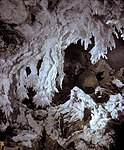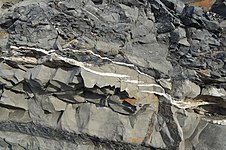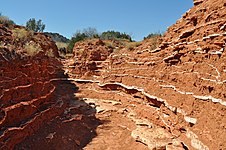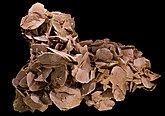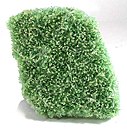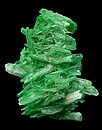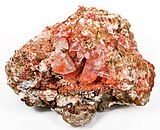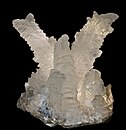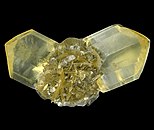Gypsum
| Gypsum | ||
|---|---|---|
2V angle 58° | | |
| Fusibility | 5 | |
| Solubility | Hot, dilute HCl | |
| References | [2][3][4] | |
| Major varieties | ||
| Satin spar | Pearly, fibrous masses | |
| Selenite | Transparent and bladed crystals | |
| Alabaster | Fine-grained, slightly colored | |
Gypsum is a soft
Fine-grained white or lightly tinted forms of gypsum known as
Etymology and history
The word
Gypsum was known in Old English as spærstān, "spear stone", referring to its crystalline projections. Thus, the word spar in mineralogy, by comparison to gypsum, refers to any non-ore mineral or crystal that forms in spearlike projections. In the mid-18th century, the German clergyman and agriculturalist Johann Friderich Mayer investigated and publicized gypsum's use as a fertilizer.[11] Gypsum may act as a source of sulfur for plant growth, and in the early 19th century, it was regarded as an almost miraculous fertilizer. American farmers were so anxious to acquire it that a lively smuggling trade with Nova Scotia evolved, resulting in the so-called "Plaster War" of 1820.[12]
Physical properties

Gypsum is moderately water-soluble (~2.0–2.5 g/L at 25 °C)
The structure of gypsum consists of layers of calcium (Ca2+) and sulfate (SO2−4) ions tightly bound together. These layers are bonded by sheets of
Crystal varieties
Gypsum occurs in nature as flattened and often twinned crystals, and transparent, cleavable masses called selenite. Selenite contains no significant selenium; rather, both substances were named for the ancient Greek word for the Moon.
Selenite may also occur in a silky, fibrous form, in which case it is commonly called "satin spar". Finally, it may also be granular or quite compact. In hand-sized samples, it can be anywhere from transparent to opaque. A very fine-grained white or lightly tinted variety of gypsum, called alabaster, is prized for ornamental work of various sorts. In arid areas, gypsum can occur in a flower-like form, typically opaque, with embedded sand grains called desert rose. It also forms some of the largest crystals found in nature, up to 12 m (39 ft) long, in the form of selenite.[15]
Occurrence
Gypsum is a common mineral, with thick and extensive
Because gypsum dissolves over time in water, gypsum is rarely found in the form of sand. However, the unique conditions of the White Sands National Park in the US state of New Mexico have created a 710 km2 (270 sq mi) expanse of white gypsum sand, enough to supply the US construction industry with drywall for 1,000 years.[18] Commercial exploitation of the area, strongly opposed by area residents, was permanently prevented in 1933 when President Herbert Hoover declared the gypsum dunes a protected national monument.
Gypsum is also formed as a by-product of
Orbital pictures from the
-
Large gypsum crystals in Lechuguilla Cave's "chandelier ballroom"
-
Gypsum crystals in the Cave of the Crystals in Mexico (person at lower right for scale)
-
Gypsum crystals formed as the water evaporated in Lake Lucero, White Sands National Park
-
Gypsum veins in the silts/marls of the Tea Green and Grey Marls, Blue Anchor, Somerset, United Kingdom
-
Gypsum veins in Caprock Canyons State Park and Trailway, Texas
-
Dunes made of small crystals of gypsum, White Sands National Park
Mining
| Country | Production | Reserves |
|---|---|---|
| China | 132,000 | — |
| Iran | 22,000 | 1,600 |
| Thailand | 12,500 | — |
| United States | 11,500 | 700,000 |
| Turkey | 10,000 | — |
| Spain | 6,400 | — |
| Mexico | 5,300 | — |
| Japan | 5,000 | — |
| Russia | 4,500 | — |
| Italy | 4,100 | — |
| India | 3,500 | 39,000 |
| Australia | 3,500 | — |
| Oman | 3,500 | — |
| Brazil | 3,300 | 290,000 |
| France | 3,300 | — |
| Canada | 2,700 | 450,000 |
| Saudi Arabia | 2,400 | — |
| Algeria | 2,200 | — |
| Germany | 1,800 | 450,000 |
| Argentina | 1,400 | — |
| Pakistan | 1,300 | — |
| United Kingdom | 1,200 | 55,000 |
| Other countries | 15,000 | — |
| World total | 258,000 | — |
Commercial quantities of gypsum are found in the cities of
Crystals of gypsum up to 11 m (36 ft) long have been found in the caves of the Naica Mine of Chihuahua, Mexico. The crystals thrived in the cave's extremely rare and stable natural environment. Temperatures stayed at 58 °C (136 °F), and the cave was filled with mineral-rich water that drove the crystals' growth. The largest of those crystals weighs 55 tonnes (61 short tons) and is around 500,000 years old.[27]
-
Golden gypsum crystals from Winnipeg
Synthesis
Synthetic gypsum is produced as a waste product or by-product in a range of industrial processes.
Desulfurization
Desalination
Gypsum precipitates onto brackish water
A new study has suggested that the formation of gypsum starts as tiny crystals of a mineral called bassanite (2CaSO4·H2O).[30] This process occurs via a three-stage pathway:
- homogeneous nucleation of nanocrystalline bassanite;
- self-assembly of bassanite into aggregates, and
- transformation of bassanite into gypsum.
Refinery waste
The production of
Impurities in refinery gypsum waste have, in many cases, prevented them from being used as normal gypsum in fields such as construction. As a result, waste gypsum is stored in stacks indefinitely, with significant risk of leaching their contaminants into water and soil.[31] To reduce the accumulation and ultimately clear out these stacks, research is underway to find more applications for such waste products.[32]
Occupational safety
| NFPA 704 fire diamond | |
|---|---|
Gypsum |
People can be exposed to gypsum in the workplace by breathing it in, skin contact, and eye contact. Calcium sulfate per se is nontoxic and is even approved as a food additive,[34] but as powdered gypsum, it can irritate skin and mucous membranes.[35]
United States
The Occupational Safety and Health Administration (OSHA) has set the legal limit (permissible exposure limit) for gypsum exposure in the workplace as TWA 15 mg/m3 for total exposure and TWA 5 mg/m3 for respiratory exposure over an eight-hour workday. The National Institute for Occupational Safety and Health (NIOSH) has set a recommended exposure limit (REL) of TWA 10 mg/m3 for total exposure and TWA 5 mg/m3 for respiratory exposure over an eight-hour workday.[35]
Uses



Gypsum is used in a wide variety of applications:
Construction industry
- Gypsum board[36] is primarily used as a finish for walls and ceilings, and is known in construction as plasterboard, "sheetrock", or drywall. Gypsum provides a degree of fire-resistance to these materials and glass fibers are added to their composition to accentuate this effect. Gypsum has little heat conductivity, giving its plaster some insulative properties.[37]
- Gypsum blocks are used like concrete blocks in building construction.
- Gypsum mortaris an ancient mortar used in building construction.
- A component of Portland cement used to prevent flash setting (too rapid hardening) of concrete.
- A wood substitute in the ancient world: For example, when wood became scarce due to deforestation on Bronze Age Crete, gypsum was employed in building construction at locations where wood was previously used.[38]
Agriculture
- Fertilizer: In the late 18th and early 19th centuries, Nova Scotia gypsum, often referred to as plaster, was a highly sought fertilizer for wheat fields in the United States.[39] Gypsum provides two of the secondary plant macronutrients, calcium and sulfur. Unlike limestone, it generally does not affect soil pH.[40]
- soluble form of boron (sodium metaborate) is converted to the less soluble calcium metaborate. Exchangeable sodium percentage is also reduced by gypsum application.[41][42] The Zuiderzee Works uses gypsum for the recovered land.[43]
- Other soil conditioner uses: Gypsum reduces aluminium and boron toxicity in acidic soils. It also improves soil structure, improving water absorption and aeration.[40]
- Soil water potential monitoring: a gypsum block can be inserted into soil, its electrical resistance measured to derive soil moisture.[44]
Modeling, sculpture and art
- Plaster for casting moulds and modeling.
- As alabaster, a material for sculpture, it was used especially in the ancient world before steel was developed, when its relative softness made it much easier to carve.[45] During the Middle Ages and Renaissance, it was preferred even to marble.[46]
- In the medieval period, scribes and illuminators used it as an ingredient in gesso, which was applied to illuminated letters and gilded with gold in illuminated manuscripts.[47]
Food and drink
- A tofu (soy bean curd) coagulant, making it ultimately a significant source of dietary calcium.[48]
- Adding hardness to water used for brewing.[49]
- Used in baking as a dough conditioner, reducing stickiness, and as a baked-goods source of dietary calcium.[50] The primary component of mineral yeast food.[51]
- Used in mushroom cultivation to stop grains from clumping together.
Medicine and cosmetics
Other
- An alternative to iron oxide in some thermite mixes.[54]
- Tests have shown that gypsum can be used to remove pollutants such as lead[55] or arsenic[56][57] from contaminated waters.
Gallery
- Unusual gypsum specimens from around the world
-
Green gypsum crystals from Pernatty Lagoon, Mt Gunson, South Australia - its green color is due to presence of copper ions.
-
Unusual selenite gypsum from the Red River, Winnipeg, Manitoba, Canada
-
Classic "ram's horn" gypsum from Santa Eulalia, Chihuahua, Mexico, 7.5×4.3×3.8 cm
-
Desert rose, 47 cm long
-
Gypsum from Pernatty Lagoon, Mt Gunson, Stuart Shelf area, Andamooka Ranges - Lake Torrens area, South Australia, Australia
-
Gypsum with crystalline native copper inside
-
Gypsum from Swan Hill, Victoria, Australia. The coloring is due to the copper oxide
-
Waterclear twined crystal of the form known as "Roman sword". Fuentes de Ebro, Zaragoza (Spain)
-
Bright, cherry-red gypsum crystals 2.5 cm in height colored by rich inclusions of the rare mineral botryogen
-
Gypsum from Naica, Mun. de Saucillo, Chihuahua, Mexico
-
Golden color gem, "fishtail"-twinned crystals of gypsum sitting atop a "ball" of gypsum which is composed of several single bladed crystals
See also
References
- S2CID 235729616.
- ISBN 978-0962209703. Archived(PDF) from the original on 6 February 2006.
- ^ Gypsum. Mindat
- ^ ISBN 978-0-471-80580-9
- ^ Institute, Canadian Conservation (14 September 2017). "Care of Objects Made of Plaster of Paris – Canadian Conservation Institute (CCI) Notes 12/2". www.canada.ca. Retrieved 20 January 2023.
- ^ Make your own sidewalk chalk. (1998, July 21). Christian Science Monitor. 13.
- ^ "Plaster | Definition, Uses, Types, & Facts | Britannica". www.britannica.com. Retrieved 20 January 2023.
- ^ "Definition of DRYWALL". www.merriam-webster.com. Retrieved 20 January 2023.
- ^ "Compact Oxford English Dictionary: gypsum". Archived from the original on 19 July 2012.
- PMID 28567158.
- ^ See:
- Thaer, Albrecht Daniel; Shaw, William, trans.; Johnson, Cuthbert W., trans. (1844). The Principles of Agriculture. Vol. 1. London, England: Ridgway. pp. 519–520.
{{cite book}}: CS1 maint: multiple names: authors list (link) - Klaus Herrmann (1990), "Mayer, Johann Friedrich", Neue Deutsche Biographie (in German), vol. 16, Berlin: Duncker & Humblot, pp. 544–545; (full text online) From p. 544: " … er bewirtschaftete nebenbei ein Pfarrgüttchen, … für die Düngung der Felder mit dem in den nahen Waldenburger Bergen gefundenen Gips einsetzte." ( … he also managed a small parson's estate, on which he repeatedly conducted agricultural experiments. In 1768, he first published the fruits of his experiences during this time as "Instruction about Gypsum", in which he espoused the fertilizing of fields with the gypsum that was found in the nearby Waldenburg mountains.)
- Beckmann, Johann (1775). Grundsätze der deutschen Landwirthschaft [Fundamentals of German Agriculture] (in German) (2nd ed.). Göttingen, (Germany): Johann Christian Dieterich. p. 60. From p. 60: "Schon seit undenklichen Zeiten … ein Gewinn zu erhalten seyn wird." (Since times immemorial, in our vicinity, in the ministry of Niedeck [a village southeast of Göttingen], one has already made this use of gypsum; but Mr. Mayer has the merit to have made it generally known. In the History of Farming in Kupferzell, he had depicted a crushing mill (p. 74), in order to pulverize gypsum, from which a profit has been obtained, albeit with difficulty.)
- Mayer, Johann Friderich (1768). Lehre vom Gyps als vorzueglich guten Dung zu allen Erd-Gewaechsen auf Aeckern und Wiesen, Hopfen- und Weinbergen [Instruction in gypsum as an ideal good manure for all things grown in soil on fields and pastures, hops yards and vineyards] (in German). Anspach, (Germany): Jacob Christoph Posch.
- Thaer, Albrecht Daniel; Shaw, William, trans.; Johnson, Cuthbert W., trans. (1844). The Principles of Agriculture. Vol. 1. London, England: Ridgway. pp. 519–520.
- ISBN 978-0-8130-2986-3.
- ^ doi:10.1139/v61-228.
- .
- hdl:10261/3439. Archived(PDF) from the original on 16 August 2017.
- S2CID 4716.
- ISBN 978-0-582-44210-8.
- ^ Abarr, James (7 February 1999). "Sea of sand". The Albuquerque Journal. Archived from the original on 30 June 2006. Retrieved 27 January 2007.
- S2CID 4606551.
- .
- ISBN 978-3527306732.
- ^ High-resolution Mars image gallery. University of Arizona
- ^ NASA Mars Rover Finds Mineral Vein Deposited by Water, NASA, 7 December 2011.
- ^ "GYPSUM" (PDF). U.S. Geological Survey. Archived (PDF) from the original on 12 December 2016.
- ^ "Mines, mills and concentrators in Canada". Natural Resources Canada. 24 October 2005. Archived from the original on 13 March 2005. Retrieved 27 January 2007.
- ^ The Hutchinson Unabridged Encyclopedia with Atlas and Weather Guide. Helion. 2018 – via Credo Reference.
- ^ Alleyne, Richard (27 October 2008). "World's largest crystal discovered in Mexican cave". The Telegraph. London. Retrieved 6 June 2009.
- PMID 31561139.
- .
- S2CID 9355745.
- ^ PMID 19406560.
- ^ (PDF) from the original on 25 March 2022.
- ^ Michigan Gypsum. "MATERIAL SAFETY DATA SHEET Gypsum (Calcium Sulfate Dihydrate)" (PDF). Consumer Information. NorthCentral Missouri College. Archived (PDF) from the original on 21 November 2021. Retrieved 21 November 2021.
- ^ "Compound Summary for CID 24497 – Calcium Sulfate". PubChem.
- ^ a b "CDC – NIOSH Pocket Guide to Chemical Hazards – Gypsum". www.cdc.gov. Retrieved 3 November 2015.
- ^ *Complimentary list of MasterFormat 2004 Edition numbers and titles (large PDF document)
- ^ Bonewitz, Ronald (2008). Rock and Gem: The Definitive Guide to Rocks, Minerals, Gems, and Fossils. United States: DK. p. 47.
- ^ Hogan, C. Michael (2007). "Knossos fieldnotes". Modern Antiquarian.
- JSTOR 3739630.
- ^ a b "Gypsum as an agricultural product | Soil Science Society of America". www.soils.org.
- ^ Genesis and Management of Sodic (Alkali) Soils. (2017). (n.p.): Scientific Publishers.
- .
- ^ Ley, Willy (October 1961). "The Home-Made Land". For Your Information. Galaxy Science Fiction. pp. 92–106.
- ISBN 978-0471491033. Archived(PDF) from the original on 16 June 2022. Retrieved 23 May 2022.
- ISBN 978-3-540-78593-4.
- PMID 29078309.
- ISBN 9780892362172.)
{{cite book}}: CS1 maint: location missing publisher (link - ISBN 9781928914044.
- ^ Palmer, John. "Water Chemistry Adjustment for Extract Brewing". HowToBrew.com. Retrieved 15 December 2008.
- ^ "Calcium sulphate for the baking industry" (PDF). United States Gypsum Company. Archived from the original (PDF) on 4 July 2013. Retrieved 1 March 2013.
- ^ "Tech sheet for yeast food" (PDF). Lesaffre Yeast Corporation. Archived from the original (PDF) on 29 October 2013. Retrieved 1 March 2013.
- PMID 6347885.
- PMID 2106026.
- S2CID 206483977.
- (PDF) from the original on 9 August 2017.
- S2CID 98249784.
- .
External links
- WebMineral data
- Mineral galleries – gypsum
- CDC – NIOSH Pocket Guide to Chemical Hazards
- . Encyclopædia Britannica (11th ed.). 1911.
- . The American Cyclopædia. 1879.

